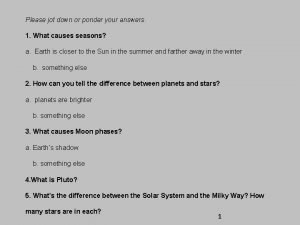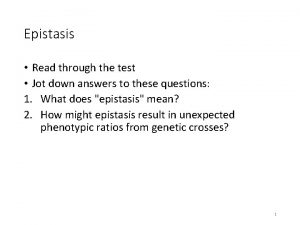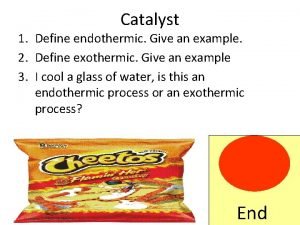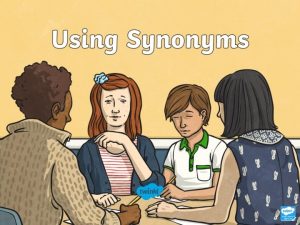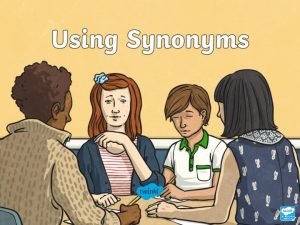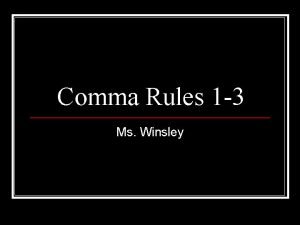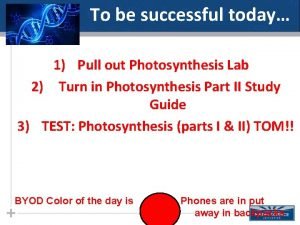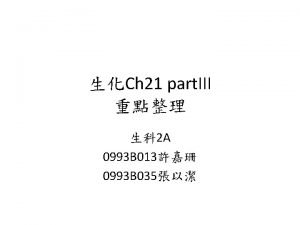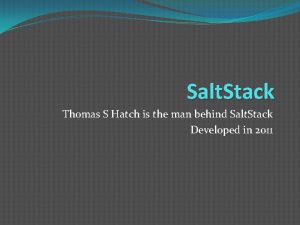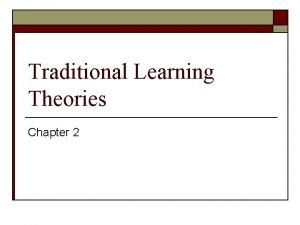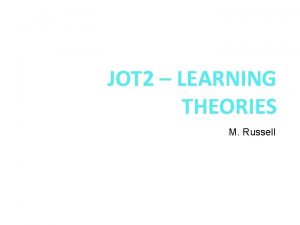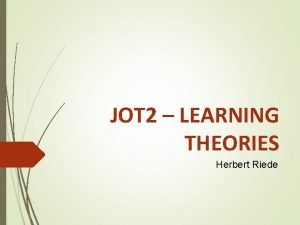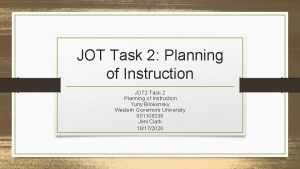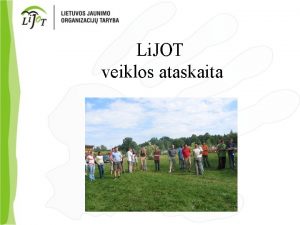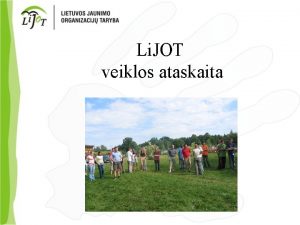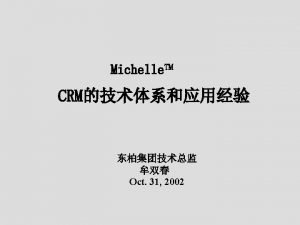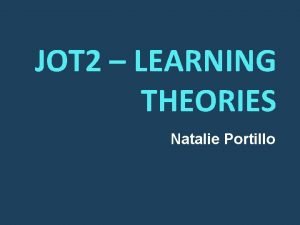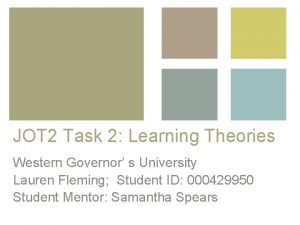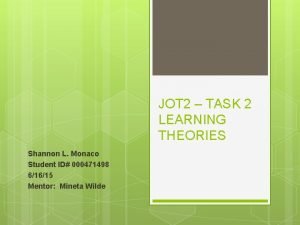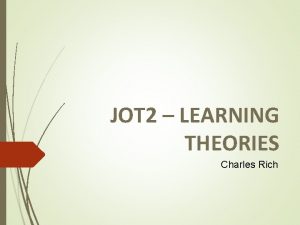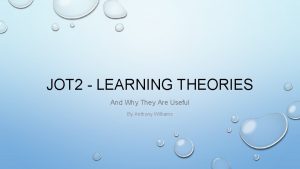JOT 2 LEARNING THEORIES Michelle Hatch NOTE Please




























- Slides: 28

JOT 2 – LEARNING THEORIES Michelle Hatch NOTE: Please be sure to download the actual assessment task and rubric from Task. Stream and carefully read what each task requires.

Task A: Learning Theories & Learners Constructivism, Cognitivism, Behaviorism

When Constructivism is Beneficial for Learners ●Hands-on learning ●Science experiments ●Discovery learning ●Scaffolding ●Connecting old information to new information ●Reviewing concepts previously learned

When Cognitivism is Beneficial for Learners ●Direct instruction ●Memorizing rules ●Memorizing facts ●Using schema or prior knowledge ●Making connections to information already stored in the brain

When Behaviorism is Beneficial for Learners ●Classroom management ●Point system ●Time-out or wall recess ●Responding to students’ responses ●Praising participation or answers

Task B: Learning Theory Used in Lesson Plan

The learning theory used in this lesson plan is the Cognitive Learning Theory as students are given direct instructions about the rules of letter sounds.

Task C: Adaptation of Lesson Plan

Constructivism ● ● ● Can easily be adapted to the Constructivist learning theory by inverting roles during the “I do” section of the lesson. Ask for suggestions from the students for items in the classroom that start like cat. The students should then notice that the words have something in common: they all start with the letter C.

Behaviorism ●Easily implemented into “check for understanding section. ” ●If the word starts with the letter C, students should give a thumbs-up, otherwise a thumbs-down. ●Students who respond correctly will be allowed to stay on their desks, while students who respond incorrectly will be asked to sit in their seats.

Task D: Lesson Plan Discussion

Constructivist Learning Theory is more appropriate for kindergarten audience. ● Hands-on learners ● Student-involved learning ● Shorter intervals

Task E: Effective Instruction Through the Use of Design Theories

Theories of Design and Effective Instruction ●Instructional Design is “The systematic process by which instructional materials are designed, developed, and delivered… Instructional design models typically specify a method, that if followed will facilitate the transfer of knowledge, skills and attitude to the recipient or acquirer of the instruction (What is Instructional Design, 2012). ”

For Example: Gagne’s Nine Events 1. 2. 3. 4. 5. 6. 7. 8. 9. Gain Attention Provide a Learning Objective Recall Prior Knowledge Present Materials Provide Guidance for Learning Elicit Performance Provide Feedback Assess Performance Enhance Retention (Clark, 2014)

Task F: Design Theories Strengths and Limitations: ● Wiggins ● Gagne ● Teaching for Understand (The Harvard model)

Wiggins Backward Design 1. Identify desired results 2. Determine acceptable evidence 3. Plan learning experiences and instruction 1. Knowledge, skills, and procedures 2. Materials 3. Learning/teaching activities (Backwards Design, 2009)

Strengths of Wiggins Theory ●Teacher knows what students need to learn in order to succeed ●Easy to integrate curriculum ●Follows the idea of the Common Core

Limitations of Wiggins ●Teachers likely to “teach to the test” ●Focus on assessment ●Requires understanding of common core standards

Gagne’s Nine Events 1. 2. 3. 4. 5. 6. 7. 8. 9. Gain Attention Provide a Learning Objective Recall Prior Knowledge Present Materials Provide Guidance for Learning Elicit Performance Provide Feedback Assess Performance Enhance Retention (Clark, 2014)

Strengths of Gagne’s Events ●Teacher and students are aware of expectations/objectives ●Scaffolding is used during the recall of prior knowledge ●Students are able to practice and receive feedback before final assessment

Limitations of Gagne’s Events ●Long planning process ●Always uses cognitivism ●Little flexibility

Teaching for Understanding 1. 2. 3. 4. Generative Topics Understanding Goals Performances of Understanding Ongoing Assessment

Strengths of Teaching for Understanding ● Can be completed in any order ● Teacher can choose assessments and activities ● A variety of learning theories could be implemented http: //www. uknow. gse. harvard. edu/teaching/TC 3 -1. html

Weaknesses of Teaching for Understanding ●Not as much structure ●Directed toward nontraditional teaching

Task G: Most Suitable Design Process

Teaching for Understanding ● Best for my kindergarten setting ● ● Flexibility Various learning theories Brief or in-depth lessons Can be used in any content area

Works Cited ● Backwards Design. June 29, 2009. Edutech Wiki. Retrieved March 28, 2015 from http: //edutechwiki. unige. ch/en/Backwards_design ● Behaviorism. 2015. Learningtheories. com. Retrieved March 22, 2015 from http: //www. learning-theories. com/behaviorism. html ● Clark, Don. December 11, 2014. Robert Gagne’s Nine Steps of Instruction. Retrieved March 27, 2015 from http: //www. nwlink. com/~donclark/hrd/learning/id/nine_step_id. html ● Constructivism. 2015. Retrieved March 22, 2015 from learning-theories. com. http: //www. learning-theories. com/constructivism. html ● Flippin, Catherine H. 2012. Educational Technology and Learning Theories. Retrieved March 25, 2015 from edtechtheory. com. http: //www. edtechlearningtheory. weebly. com/cognitivism. html ● Introducing Tf. U. Learnweb. harvard. edu. Retrieved March 28, 2015 from http: //learnweb. harvard. edu/ALPS/tfu/about 3. cfm ● Mc. Leod, Saul. 2011. Bandura – Social Learning Theory. Retrieved March 22, 2015 from Simplypsychology. org. http: //www. simplypsychology. org/bandura. html ● What is Instructional Design? 2012. Instructional. Design. Central. com. Retrieved March 27, 2015 from http: //www. instructionaldesigncentral. com/htm/IDC_instructionaldesigndefinitions. htm
 Please jot down
Please jot down Jot air balloon
Jot air balloon Naczelnik osp wymagania
Naczelnik osp wymagania Jot down questions
Jot down questions Jot cheetos
Jot cheetos Jot down synonym
Jot down synonym Jot down synonym
Jot down synonym Will you please be quiet please summary
Will you please be quiet please summary Ms.winsley
Ms.winsley Difference between note making and note taking
Difference between note making and note taking Abbreviation for continued
Abbreviation for continued Difference between note making and note taking
Difference between note making and note taking Financial documents order
Financial documents order Debit note and credit note
Debit note and credit note Debit note meaning
Debit note meaning Note taking and note making
Note taking and note making Simple discount formula
Simple discount formula Hatch slack pathway
Hatch slack pathway Double yolk chicken eggs hatching
Double yolk chicken eggs hatching Mary jo hatch
Mary jo hatch Hatch-slack pathway
Hatch-slack pathway Yonsei cee
Yonsei cee Thomas hatch saltstack
Thomas hatch saltstack Ciclo hatch slack
Ciclo hatch slack Pha ti
Pha ti Proteoplasto
Proteoplasto Calvinův cyklus
Calvinův cyklus Cuadro comparativo de e-learning
Cuadro comparativo de e-learning Traditional learning theories
Traditional learning theories
